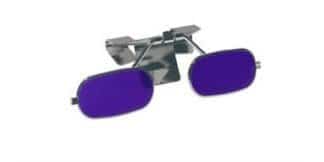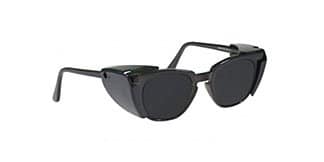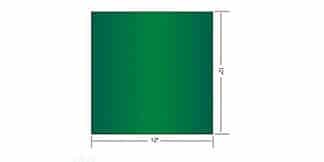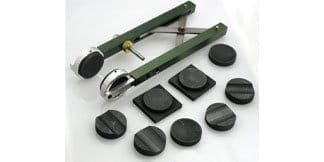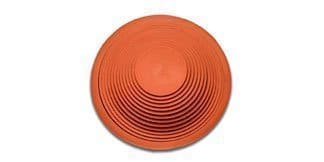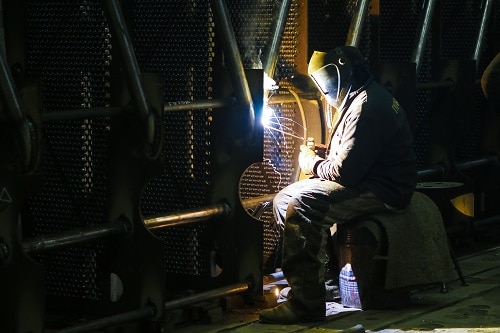If you are a new welder you will need to get to grips with how to choose the correct welding shade for the job at hand. Those who have been in the industry for some time will have an understanding on this but in this article we will look at how they make the decision about which welding shade to choose.
There are many dangers related to welding, but some of the more frequent ones include exposure to fumes from metal, Infrared (IR), Ultraviolet (UV) and intense visible light. Welders are at risk of injuries from exposure to these elements and these injuries can include damage to the eyes which could be permanent, burns, and most commonly burns to fingers, hands and arms.
The human eye cannot see UV or IR light and so you may not even be aware of the danger before it is too late. However, there are steps you can take to make your work as safe as possible and keep your eyes safe while completing your work. One of these methods is to ensure that you are using the correct welding shade for the job at hand.
Using a welding shade will ensure that your eyes are protected from the dangers outlined above.
What Is A Welding Shade?
You will need to understand the basics of what a welding shade is before making a decision on the right one to use. Welding shades are dark filters that will allow you to view the welding arc while keeping your vision safe. We need these shades as the welding arc is brighter than the sun which as we know can damage our eyes when it is looked at directly with no protection.
Welding shades come in a variety of coloured filters and can be found in a variety of eyewear which includes safety glasses, welding helmets, goggles or face shields. Most likely within your job you will be using a welding helmet or welding face shield. With that in mind, lets have a look at the types of shades available.
You will need to consider the type of welding application before you decide which filter to use. To ensure you are using the correct welding shade there is guidance available on the Health and Safety Executives website.
The Health and Safety Executive (HSE) is a UK government agency responsible for the encouragement, regulation and enforcement of workplace health, safety and welfare, and for research into occupational risks in Great Britain.
Health and Safety Executive Guidance
The HSE recommends starting with a shade that is too dark to see the welding area. This is a safe place to start to work backwards from in order to find a lighter shade that allows you to see the weld while not allowing you to go below the recommended shade to view your weld. You do, of course, need to see the weld to make it so although this is a conservative approach it is one that will safeguard your vision.
The shade number of your welding lens will indicate the intensity of the light radiation that can pass through it. The higher the shade number the darker the filter will be, and less radiation can pass through these higher filters and they can best protect your eyes. The guidance provided will provide the minimum lens shade number so please take that into account when making your decision.
You will need to examine this guidance and work out which application you are using and therefore which lens is applicable for the situation. Further guidance on welding shades can be found on the HSE website.
The HSE have compiled several advice sheets on controlling the risk of welding which we have included a link to here. There are also several useful videos on the site that you can use to determine how safely you are working with your weld.
Other Equipment Required For Safe Welding
As stated previously, you will already be using a welding helmet or face shield when carrying out your work. Some face shields will allow you to remove and replace the welding shades in relation to what weld you are carrying out. You may also be able to use auto-darkening lenses.
These can be useful additions in the workplace as they allow you to perform a wide range of welds which may have otherwise required you to change shades. When using equipment, you will need to ensure that it complies with HSE standards and that you are protecting yourself at all times. You should always carry out a risk assessment on your job or have your health and safety officer do one for you. This will not only protect you from the dangers in the workplace but will help to keep your colleagues safe and your employer on the right side of the HSE.
Remember that more often than not you cannot see the light that extends from your welding work so you will need to take the necessary precautions when carrying out this type of work. It may seem excessive to carry out these practices however these precautions can help to prevent permanent eye damage and safeguard you will you are in the workplace.
In Conclusion
Choosing to become a welder can be a great career choice and can provide job satisfaction in that you get to see the finished product going out the door and knowing that you have had a hand in creating something that could make a difference in the lives of those around you. However to keep doing this you will need to ensure you protect yourself appropriately to keep doing the job you love.
Purchasing a welding shade may not be cheap but despite hitting your pocket in the early stages this protection can provide safeguarding to you throughout your career.
By investing in welding shades, you will have the confidence that your eyes are sufficiently protected, giving you peace of mind to complete your best work.
View our range of welding shades or contact us for more information.

